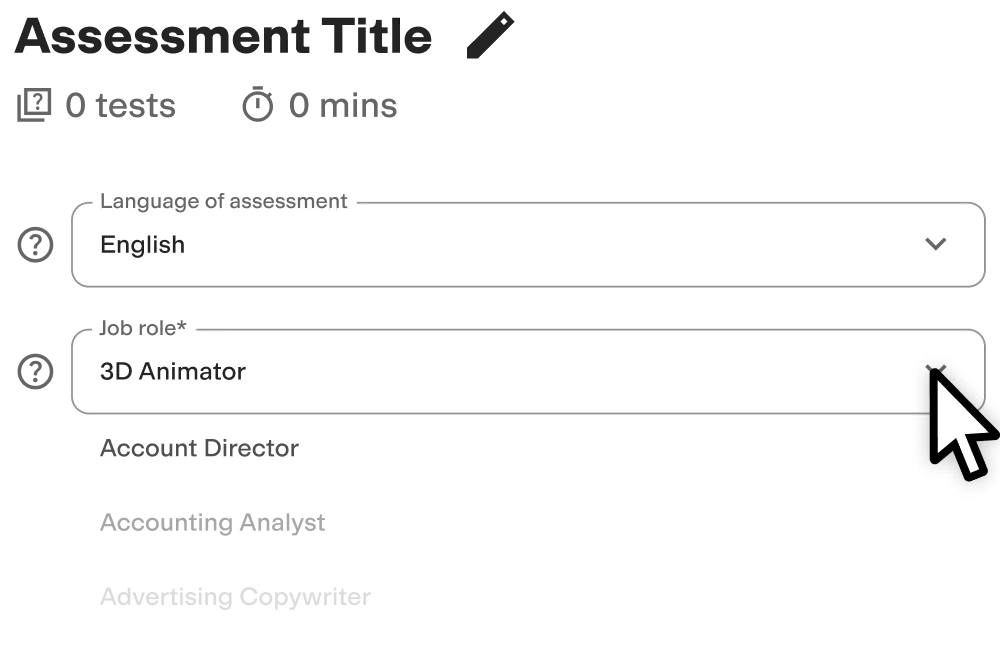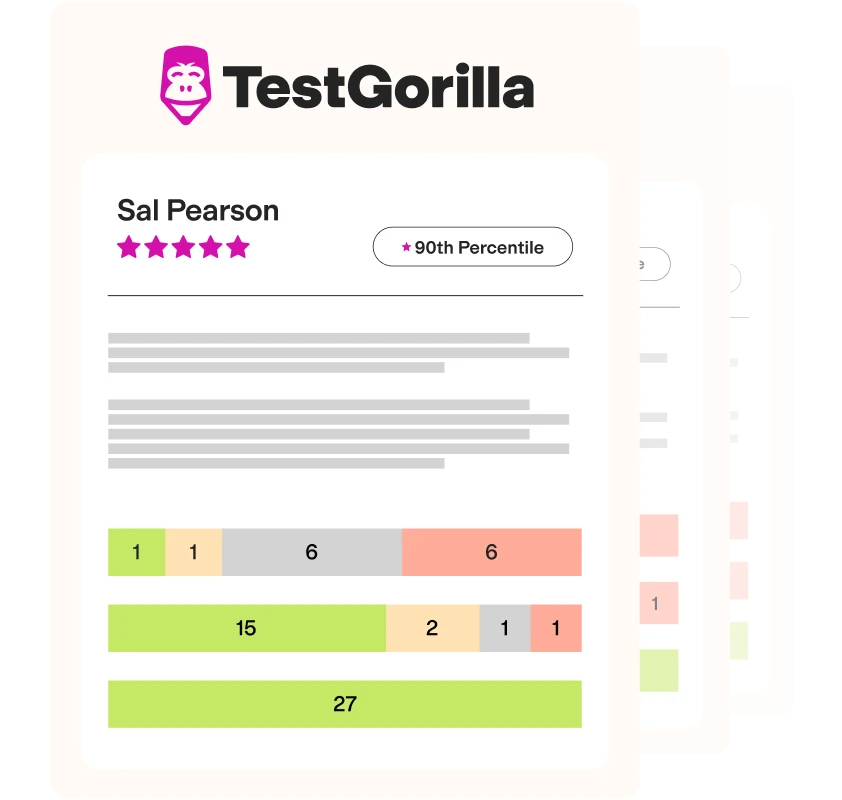Software Architect test
Summary of the Software Architect test
This Software Architect test evaluates candidates’ ability to analyze the needs and priorities of technological projects and make architectural decisions on different software design scenarios. This test helps you identify experienced software architects.
Covered skills
Proposing working technological solutions
Conducting tradeoff analysis
Understanding software architecture principles
Use the Software Architect test to hire
Software architects and other roles that require a strong (advanced) grasp of software architecture principles and implementation.
About the Software Architect test
Organizations focused on developing technological solutions need good software architects that can analyze the requirements of each project, evaluate the pros and cons of different designs and technologies, and come up with optimal solutions for each case.
A good software architect must not only have a broad knowledge of tools and technologies available but must also be able to evaluate the trade-offs of each choice and analyze its consequences objectively according to the best principles and practices of software design.
This Software Architect test helps you identify candidates who have the knowledge and skills required to carry out the architectural design of technological projects. Through various real-life scenarios, this test evaluates candidates' ability to conduct trade-off analysis, propose working technological solutions, and follow primary software architecture principles.
Candidates who perform well on this screening test, have experience with a broad variety of technological tools, can define the success criteria of a system so that it functions properly, and can direct development teams on the capabilities and constraints of each system and design.
The test is made by a subject-matter expert
TestGorilla’s tests are created by subject matter experts. We assess potential subject-matter experts based on their knowledge, ability, and reputation.Before being published, each test is peer-reviewed by another expert, then calibrated using hundreds of test takers with relevant experience in the subject.
Our feedback mechanisms and unique algorithms allow our subject-matter experts to constantly improve their tests.
Sridhar G.
A former Amazon engineer, Sridhar has been involved in the field of software development for over 12 years. During this time, he has built high-performance services and architected backends scaling to serve millions of users.
He currently focuses on decentralization technologies and smart contracts and works as an external CTO advising companies on how to automate their businesses while they focus on growing their user base and clients.
Use TestGorilla to hire the best faster, easier and bias-free
Our screening tests identify the best candidates and make your hiring decisions faster, easier, and bias-free.
Create high-quality assessments, fast
Building assessments is a breeze with TestGorilla. Get started with these simple steps.
Why software architecture is important development
Software architecture refers to the structure a software system is built on. How well this structure is created determines how efficiently and reliably your software performs in the long run. When building software architecture, you should follow a few key principles. Specifically, the software architecture needs to:
Function without bugs
Perform reliably, even under stress (it should run correctly under a heavy load)
Be able to be maintained without interrupting the current processes
Protect data and be secure from attacks
Have clean source code (or it will be difficult to change and maintain later)
Be modular (divided into modules that operate independently)
Creating effective software architecture is important early on in the software development process since all of the later stages depend on it. That’s why it’s critical for you to pick the right candidate when hiring for a role that involves working on your software architecture.
Software architects are responsible for creating the fundamental building blocks of an entire software network. Therefore, when hiring a software architect, you need to make sure that you pick a candidate who you can trust to create the foundation of your software. If you choose the wrong applicant, the effects of that decision will be felt for years in your software development process.
The benefits of good software architecture
When a software architect creates good software architecture, the benefits are endless. Here are the three top benefits of effective software architecture.
A solution that meets all your requirements
When installing software in your company, you want it to solve all your problems and meet all of the requirements, whether they’re functional, technical, or operational. To fully understand the software’s requirements, you’ll have to work with different stakeholders, such as product development employees, domain experts, and end-users.
Once this information has been gathered, the software architect will then use it to create a software architecture that meets all of the requirements.
Good software architecture satisfies the requirements of all stakeholders and elegantly follows software architecture principles. On the other hand, poor software architecture fails to meet stakeholders’ requirements or is implemented inefficiently. Bad software architecture can be difficult or even impossible to maintain and manage.
Enables easy communication with different stakeholders
With software architecture, you can share all of your documentation with different stakeholders. Even though different departments will have different inputs, priorities, and goals, the software architecture will provide a common language for all of them through architecture design artifacts.
This is extremely useful for large and complex systems that would otherwise have too many different inputs, making it impossible to fully understand all of them.
Creates the right foundation for adapting and changing software
It’s only a matter of time before you will have to make changes to your software system. There can be many reasons for this, such as new technologies that arrive on the market, a bug that creates problems in the network, or simply new requirements due to business growth.
When you have the right software architecture, it will be easy to make changes and adapt your software accordingly. But poor architecture will crumble down under all of the changes your developers are trying to make. To ensure that doesn’t happen, you need a good software architect who can plan ahead.
Find top candidates with the Software Architect test
Given the importance of good software architecture, you need to make sure that you choose the right candidate for your software architect role. A pre-employment test such as the Software Architect test can help you achieve this in multiple ways:
• It’s bias-free: Instead of using CV screening in your hiring process, you should give all of your candidates a pre-employment test like the Software Architect test. The bias that comes with CV screening can cause many good candidates to fall through the cracks, and some false positives can manage to get through the hiring process. But with a pre-employment test, all of the candidates get a chance to show their skills.
• It’s easy and simple to use: Going over dozens or even hundreds of CVs manually is a time-consuming task, and eventually, focus drops and bias creeps in. But with a pre-employment test, you simply send the test with a single click to all of the applicants in the hiring process. Whether you have 30 or 300 candidates, you can send all of them the Software Architect test instantly and wait for the results.
• It scores candidates objectively: All the candidates will complete the same test with the same questions, eliminating bias from the hiring process. On top of that, you get numerical results that enable you to compare candidates with ease. You can be confident that those who score better on the test have more experience, knowledge, and skill when it comes to software architecture.
In summary
Software architecture is the foundation of all of your software, so you need to make sure that it is solid and can withstand changes. That’s why you need to hire a software architect who will create long-lasting software architecture for your organization.
With a pre-employment test like the Software Architect test, you can eliminate bias from the hiring process, make data-driven hiring decisions, and streamline your recruitment process. This helps you hire only the candidates who proved their skills objectively by scoring well on the test.
FAQs
View a sample report
The Software Architect test will be included in a PDF report along with the other tests from your assessment. You can easily download and share this report with colleagues and candidates.







